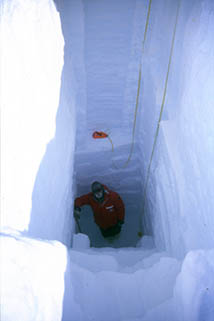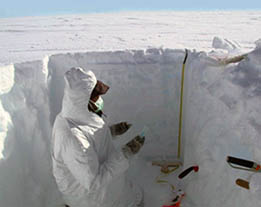Volcanic activity can have serious consequences for climate change as particles and gases spewed out by volcanoes enter the upper atmosphere and change its chemical balance altering how Solar radiation is absorbed or reflected. Now, French and US researchers have devised a technique for determining how past volcanic eruptions could have affected this delicate chemical balance. Their findings could reduce significantly the uncertainty in current models of global climate change and so provide more accurate predictions of future global temperatures.
Joël Savarino of the National Center for Scientific Research (CNRS) and the University of Grenoble in France together with colleagues at the University of California San Diego have reported the pattern of sulphur isotopes of volcanic fallout from past eruptions. They also determined how far into the upper atmosphere the volcanic material reached, and what chemical reactions might have occurred there.

Joël Savarino1 (© CNRS Photothèque / Joël Savarino)
The biggest errors in models of global warming and climate change hinge on atmospheric aerosols, explains team member Mark Thiemens, Now for the first time, we can account for all of the chemistry involving sulfates, which removes uncertainties in how these particles are made and transported. That’s a big deal with climate change.
Determining the height of a past volcanic eruption provides important information about its impact on climate. If volcanic material only reaches the lower atmosphere, the effects are relatively local and short term because the material is washed out by rain. Eruptions that reach up higher, into the stratosphere, have a much greater influence on climate. “In the stratosphere, sulfur dioxide that was originally in the magma gets oxidized and forms droplets of sulfuric acid,” explains team leader Savarino, This layer of acid can stay for years in the stratosphere because no liquid water is present in this part of the atmosphere. The layer thus acts as a blanket, reflecting the sunlight and therefore reducing the temperature at ground level, significantly and for many years.

Joël Savarino1 (© CNRS Photothèque / Joël Savarino)
To distinguish between upper and lower atmospheric reach of past eruptions, the researchers examined the relative concentrations of isotopes of the chemical element sulphur preserved in Antarctic ice sheets where past volcanic fallout ultimately settles. Sulphur that rises as high as the stratosphere, above the ozone layer, is exposed to short wavelength ultraviolet light. UV exposure creates a unique ratio of sulphur isotopes, so the sulphur isotope signature in fallout reveals whether or not an eruption reached stratospheric proportions or not.
The team’s measurements allowed them to match atmospheric observations as well to distinguish between the recent Pinatubo eruption and the eruption of Cerro Hudson (also known as Mount Hudson), which both occurred in the same year, 1991. Cerro Hudson, did not send material as high as the stratosphere and the fallout had a different sulphur isotope fingerprint than the fallout from Pinatubo, says the team.
Unfortunately, because of compression and distortion of deeper layers of ice, volcanic material from more ancient eruptions is less easily accessible. Nevertheless, data for relatively recent and modern eruptions are revealing the chemical secrets of volcanic activity in the upper atmosphere.
Sulphates can cause warming or cooling depending on how they are made, Thiemens adds. “They are usually white particles, which tend to reflect sunlight, but if they form on dark particles like soot, they can absorb heat and worsen warming.” Some scientists suggest that should global warming become severe, we might deliberately inject sulphate aerosols into the upper atmosphere to block incoming solar radiation. Knowing whether or not such a scheme would work or indeed be sensible will depend critically on understanding the atmospheric chemistry of sulphates, a pattern on which the current volcanic research at least sheds some light.
Further reading
Science, 2007, 315, 84-87;
http://dx.doi.org/10.1126/science.1131754
Suggested searches
volcanoes
eruptions
climate change
atmospheric chemistry